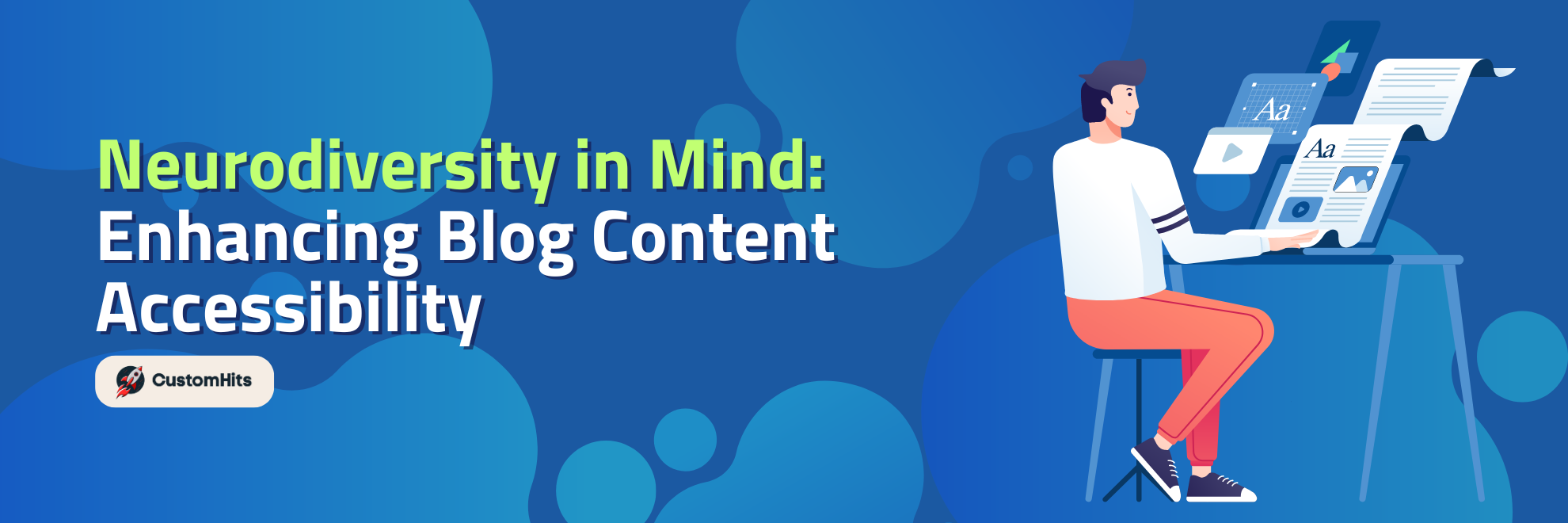

Overview
Content
In today's digital age, the importance of content accessibility cannot be overstated. It is crucial for blog creators to ensure that their content is accessible to all individuals, including those who are neurodivergent. By understanding neurodiversity and incorporating strategies to enhance accessibility, bloggers can reach a wider audience and create a more inclusive online space. In this blog post, we will explore how to make your content more accessible to neurodivergent individuals.
Understanding Neurodiversity and Content Accessibility
Content accessibility, in this context, means adapting and designing blog materials so they can be comprehensible and usable by everyone, including those with neurological differences. It involves considering how neurodivergent individuals process information and what barriers they might encounter when navigating digital content. For instance, overly complex language, dense text blocks without clear organization, and the absence of supportive visual aids can hinder understanding and retention of information. Moreover, the lack of consideration for assistive technologies that some neurodivergent readers may rely on further exacerbates accessibility issues.
Therefore, enhancing content accessibility requires a mindful approach to how information is presented. It involves not just the elimination of physical and sensory barriers but also the thoughtful structuring of content and the provision of various means of engagement to accommodate a diversity of neurological processing styles. By doing so, bloggers not only broaden their reach but also contribute to a more inclusive and understanding digital community, where everyone’s learning and interaction preferences are valued and catered to.
Simple Language, Big Impact
One effective strategy for making blog content more accessible is the deliberate choice of language. Utilizing straightforward and uncomplicated language can significantly lower barriers for readers, particularly for those who are neurodivergent. Complex terminologies, lengthy sentences, and abstract concepts can often be stumbling blocks that impede comprehension. In contrast, simple words and direct sentences facilitate easier understanding and retention of information, making the content more welcoming to a broader audience. This approach does not mean diluting the content's depth or value; rather, it involves crafting messages in a way that is accessible to everyone, regardless of their cognitive and neurological processing differences. For neurodivergent individuals, who may have unique challenges with language processing, this can make a substantial difference in their ability to engage with and benefit from online resources. Furthermore, adopting a straightforward language style also enhances the clarity of your message, ensuring that your key points are effectively communicated without unnecessary complexity. This technique not only expands the reach of your blog but also reinforces an inclusive digital ethos, demonstrating a commitment to ensuring that your content can be understood and appreciated by as wide an audience as possible. By prioritizing clear and concise language, bloggers can play a pivotal role in bridging communication gaps and creating an online space that welcomes and supports diverse ways of thinking and learning.
Structuring Your Content for Clarity
Optimizing the structure of your blog posts is critical in making your content more digestible and accessible, especially for neurodivergent readers. Organizing information using clear headings, subheadings, and visually distinct paragraphs helps in guiding readers through the content, allowing them to easily locate the information they need or are interested in. The strategic use of bullet points and numbered lists further enhances this by breaking down complex information into manageable chunks, facilitating a smoother reading experience.
Spacing and alignment also play a pivotal role in readability. Ensuring adequate spacing between lines, paragraphs, and sections can significantly reduce visual clutter. This makes the content appear less daunting and more approachable, particularly for individuals who may get overwhelmed by densely packed text. Incorporating these structural elements not only aids in navigation but also in comprehension, as it allows readers to process information at their own pace and in a manner that suits their cognitive processing style.
Moreover, using distinct font styles or colors to emphasize key points or to indicate different sections can help in drawing attention to important information without overburdening the reader with too much text or complex language. However, it's crucial to use such stylistic features sparingly and with consideration for those with visual impairments or sensitivities, ensuring that the content remains accessible to everyone.
By thoughtfully structuring content, bloggers can create an environment that respects and accommodates the diverse needs of their audience, making information not just accessible but also engaging for neurodivergent individuals. This approach underscores the significance of thoughtful content presentation as a cornerstone of inclusive digital communication.
The Role of Visuals in Enhancing Understanding
Visuals serve as powerful tools in making blog content more digestible and engaging, particularly for readers who are neurodivergent. When text is complemented with images, infographics, charts, and videos, it can transform the learning experience by providing multiple pathways for understanding. For individuals who find traditional text-heavy formats challenging, visuals can act as cognitive anchors, helping to clarify concepts and reduce the cognitive load associated with processing large amounts of textual information.
To ensure these visual elements benefit everyone, it's crucial to select images that are clear and directly relevant to the content. Infographics can be especially beneficial, as they distill complex information into easily interpretable visual formats. Meanwhile, videos can offer an alternative means of engaging with the material, particularly for those who prefer auditory or visual learning over reading. It's important to include captions or transcripts for videos to cater to those with hearing impairments or those who process information better through reading.
When incorporating visuals, attention should also be paid to the principles of design and layout. A well-structured presentation of visuals can aid in guiding the reader through the content seamlessly, making it easier to grasp the intended message. Colour contrasts, for instance, should be strong to ensure readability by individuals with visual impairments but not so vibrant as to be distracting or overwhelming.
In crafting an accessible blog, the thoughtful integration of visuals not only enriches the content but also embodies a commitment to inclusivity, ensuring that readers of all neurotypes can navigate and benefit from the information shared.
Embracing Assistive Technologies
In the digital realm, making your blog universally navigable necessitates the integration of assistive technologies. These tools are indispensable for neurodivergent individuals, enabling them to seamlessly engage with online materials. When considering assistive technologies, it's crucial to design your blog content to be compatible with screen readers, which read text aloud for users with visual impairments or reading difficulties. Additionally, incorporating text-to-speech software allows users to listen to written content, offering an alternative method for processing information that may be more suited to their needs.
Voice recognition software also merits consideration, as it enables users to navigate and interact with content through verbal commands, thus catering to individuals who find traditional keyboard and mouse interactions challenging. To optimize for these technologies, ensure that your blog's design avoids unnecessary complexity and is structured in a way that these tools can easily interpret and navigate. This means using clear, descriptive headings and alt text for images, which are critical for screen reader users to understand visual content.
By proactively incorporating these assistive technologies into your blog's design, you underscore your commitment to content accessibility, paving the way for all readers, regardless of their neurological makeup, to access and benefit from your content without barriers.
Encouraging Feedback to Improve Accessibility
Creating an inclusive blog requires more than just implementing accessibility guidelines; it necessitates an ongoing dialogue with your readership. Inviting feedback is a critical step in this process, as it opens up a channel for readers, especially those who are neurodivergent, to share their experiences and suggest enhancements. This engagement not only helps identify areas for improvement but also fosters a sense of community and belonging among your audience. To facilitate this, consider adding a dedicated feedback form or section on your blog where readers can easily express their thoughts on accessibility features and content presentation. Social media platforms can also serve as valuable forums for gathering insights directly from your audience. Remember, feedback should be seen as a gift; it provides a unique opportunity to view your blog through the lens of those it aims to serve. Actively seeking, acknowledging, and acting upon reader suggestions not only elevates the accessibility of your content but also demonstrates a genuine commitment to inclusivity. This approach ensures that your blog evolves in a direction that truly reflects and accommodates the diverse needs and preferences of your entire readership, making your digital space more welcoming and accessible to everyone.
